four wheel drive CHEVROLET S10 1993 2.G Owners Manual
[x] Cancel search | Manufacturer: CHEVROLET, Model Year: 1993, Model line: S10, Model: CHEVROLET S10 1993 2.GPages: 356, PDF Size: 20.85 MB
Page 54 of 356
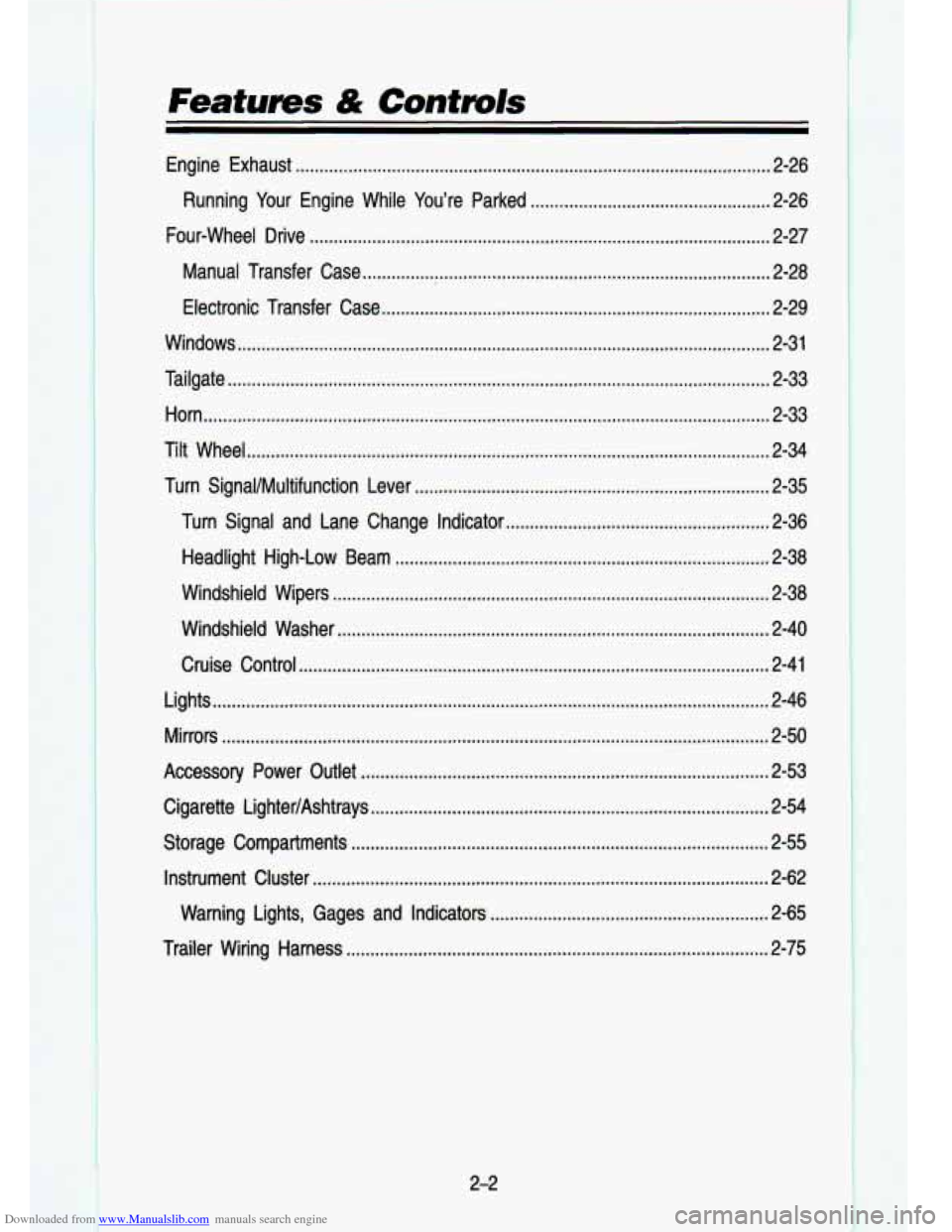
Downloaded from www.Manualslib.com manuals search engine Features & Controls
Enain laust ........................................................................\
........................... 2-26
hunnlng Your Engine While You’re Parked
.................................................. 2-26
Four-wheel Drive
........................................................................\
........................ 2-27
Manual Transfer Case
........................................................................\
............. 2-28
Electronic Transfer Case
........................................................................\
......... 2-29
Windows
........................................................................\
....................................... 2-31
Tailgate
........................................................................\
......................................... 2-33
Horn
........................................................................\
.............................................. 2-33
Tilt Wheel
........................................................................\
..................................... 2-34
Turn Signal/MuItifunction Lever
........................................................................\
.. 2-35
Turn Signal and Lane Change Indicator
....................................................... 2-36
Headlight High-Low Beam
........................................................................\
...... 2-38
Windshield Wipers
........................................................................\
................... 2-38
Windshield Washer
........................................................................\
.................. 2-40
Cruise Control
........................................................................\
.......................... 2-41
Lights
........................................................................\
............................................ 2-46
Mirrors
........................................................................\
.......................................... 2-50
Accessory Power Outlet
........................................................................\
............. 2.53
Cigarette LighteVAshtrays
........................................................................\
........... 2-54
Storage Compartments
........................................................................\
............... 2.55
Instrument Cluster
........................................................................\
................... I.rr . 2-62
Warning Lights, Gages and Indicators
.......................................................... 2-65
Trailer Wiring Harness
........................................................................\
................ 2-75
2-2
Page 69 of 356
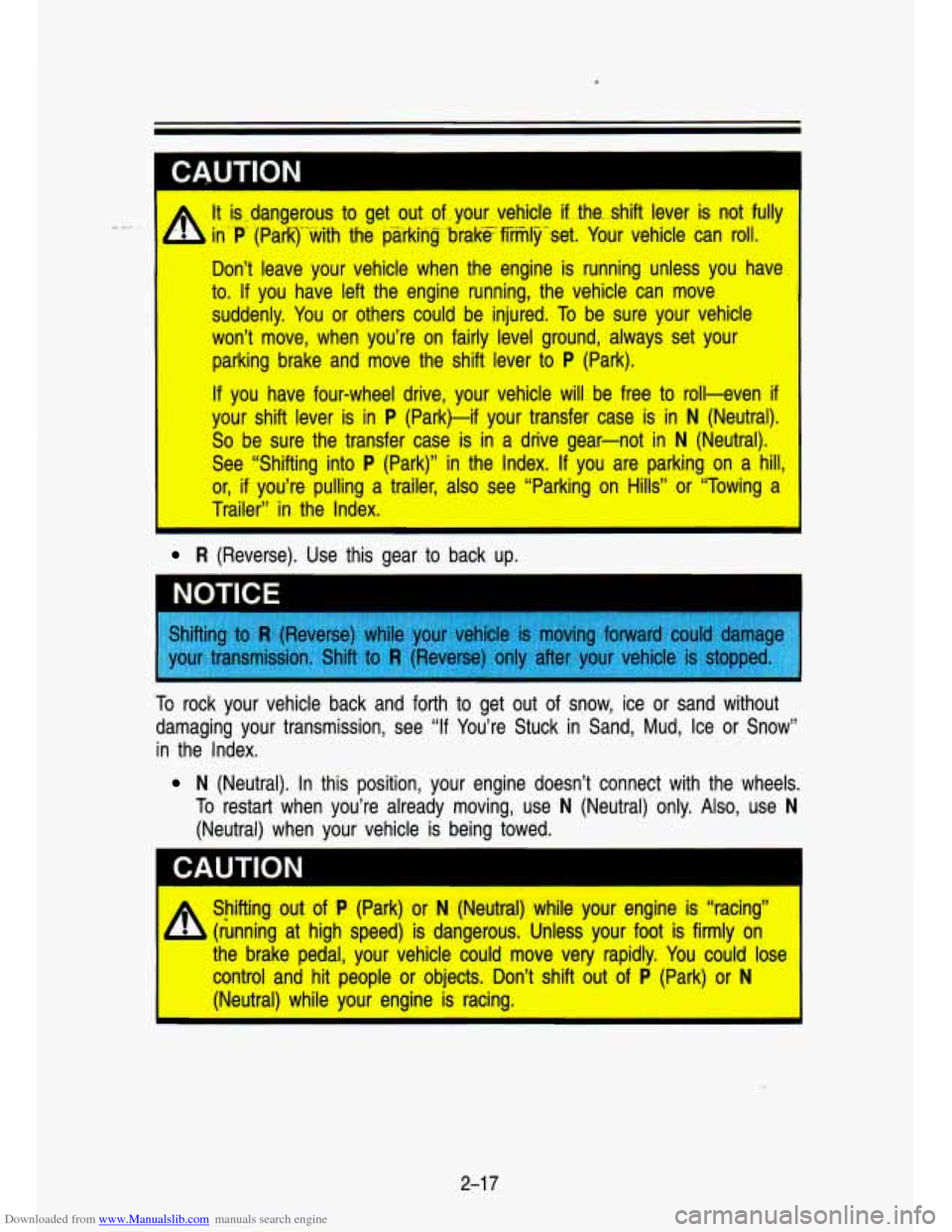
Downloaded from www.Manualslib.com manuals search engine I CAUTION
I A It is.-dangerous to get out of..your vehicle if. tha..shift lever is not fully
in-P (ParQ--wiih
the parking brake fiim~ljj-set. Yo’ur vehiclle ‘&n roll.
Doln’t leave your vehicle when the engine is running unless you have
to.
If you have left the engine running, tihe vehicle can move
suddenly. You or others could- be injured.
To be sure your vehicle
won’t move, when yolu’lre on fairly level ground, always set your
parking brake and move the shift lever to P (Park).
Of you have four-wheel drive, your vehicle will be free to roll-even if
your shift lever is in P (Park)i-if your transfer case i:s iln ‘N (Neutral).
So be sure the transfer case is in a drive gear-not in N (Neutral)’.
See “Shifting into P (Par’k)’’ in the Index. If you are ,parking on a hill,
or, if you’re p’ulling a traihr, also see “Parking on Hills” o:r “Towilnlg a
Trailer” in the Index.
R (Reverse). Use this gear to back up.
To rock your vehicle back and forth to get out of snow, ice or \
sand without
damaging your transmission, see
“If You’re Stuck in Sand, Mud, Ice or Snow”
in the Index.
N (Neutral). In this position, your engine doesn’t connect wi\
th the wheels.
To restart when you’re already moving, use N (Neutral) only. Also, use N
(Neutral) when your vehicle is being towed.
Shifting
out of P (Park) or N (Neutral) While your engine is “racing”
a (iunning aft hligh speed) is dangerous. ‘Unless your foot is firmly on
the brake ped’al,
your vehilcle could move very rapidly. You co1wl;d lose
(Neutral) while your engine is racing.
I contro’l and hit people or objects. Don’t shift out ‘of P (Park) or N
2-1 7
Page 72 of 356
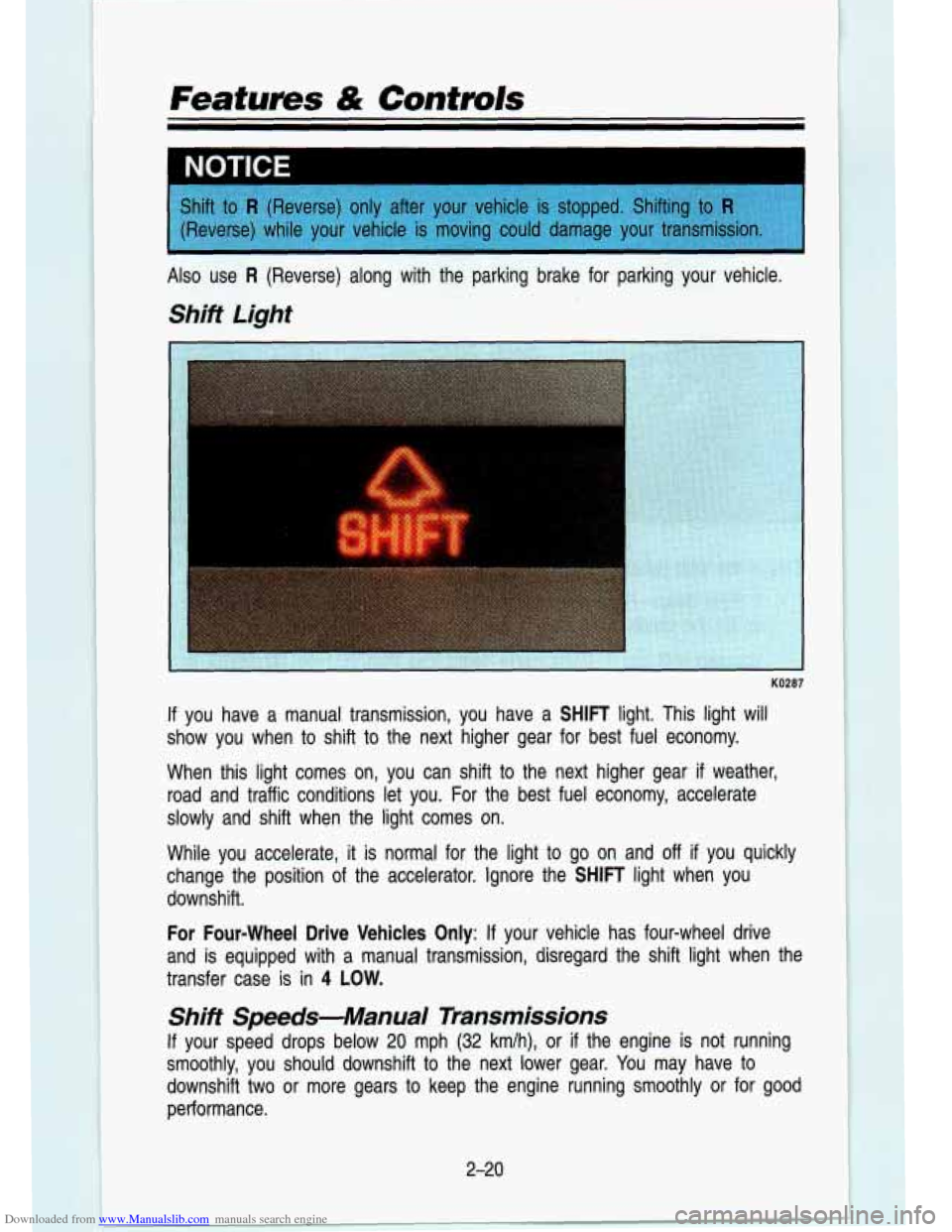
Downloaded from www.Manualslib.com manuals search engine Featurns & Controls
I
If you have a manual transmission, you have a SHIFT light. This light will
show you when
to shift to the next higher gear for best fuel economy.
When this light comes on,
you can "shift to the n-ext higher gear if weather,
road and traffic conditions let you. For the best fuel economy, accelerate
slowly and shift when the light comes on.
While you .accelerate, it
is normal for the light to go on and off if you quickly
change the position
of the accelerator. Ignore the SHIFT light when you
downshift.
For Four-wheel Drive Vehicles
Only: If your vehicle has four-wheel drive
and is equipped with a manual transmission, disregard the shift\
light when the
transfer case is in
4 LOW.
Shift Speeds-Manual Transmissions
If your speed drops below 20 mph (32 km/h), or if the engine is not running
smoothly, you should downshift
to the next lower gear. You may have to
downshift two or more gears to keep the engine running smoothly or for good
performance.
2-20
Page 75 of 356
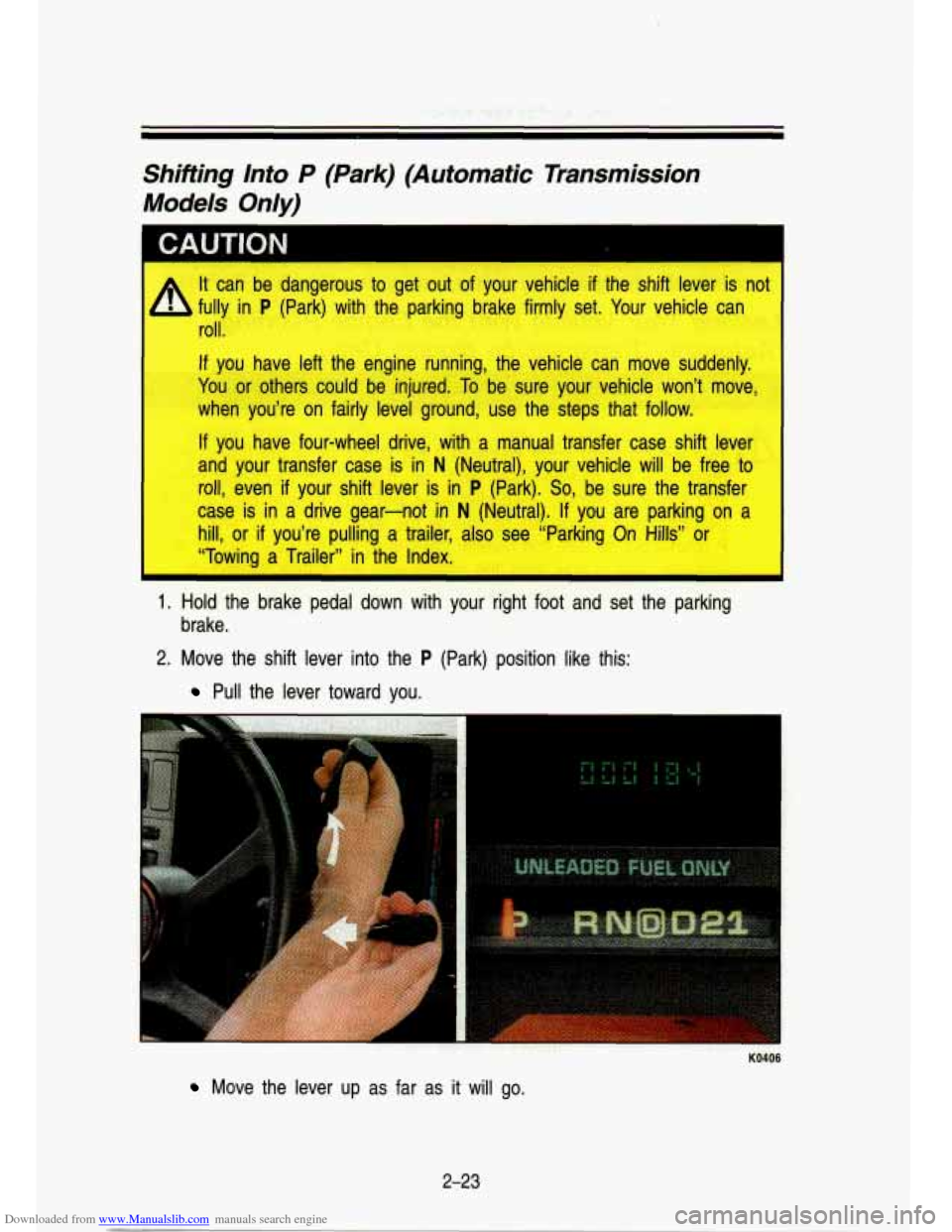
Downloaded from www.Manualslib.com manuals search engine Shifting Into P (Park) .(Automatic Transmission
Models Only)
fi A.UTION I.
It can be dangerous to get out of your vehicle if the shift lever is not I
fully in P (Park) with the parking brake firmly set. Your vehicle can
roll.
If you have left the engine running, the vehicle can move sudde..I,.
You or others could be injured.
To be sure your vehicle won’t move,
when you’re on fairly level ground, use the steps that foll\
ow.
If you have four-wheel drive, with a manual transfer case shif\
t lever
and your transfer case is in
N (Neutral), your vehicle will be free to
roll, even
if your shift lever is in P (Park). So, be sure the transfer
case is in a drive gear-not in
N (Neutral). If you are parking on a
hill, or
if you’re pulling a trailer, also see “Parking On Hills” or
“Towing a Trailer’’ in the Index.
1. Hold the brake pedal down with your right foot and set the parking
2. Move the shift lever into the P (Park) position like this:
brake.
Pull the lever toward you.
KO406
Move the lever up as far as it will go.
2-23
Page 76 of 356
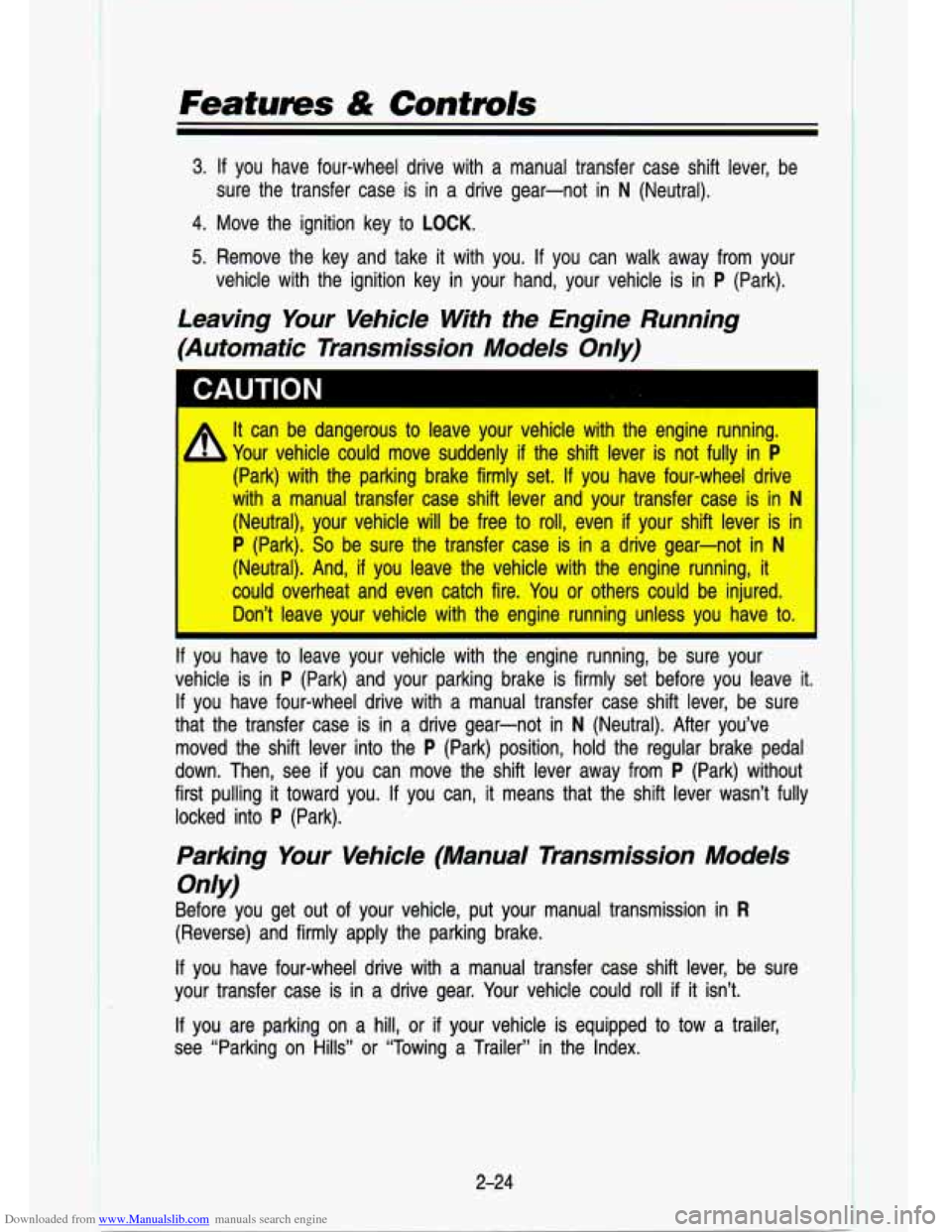
Downloaded from www.Manualslib.com manuals search engine Features & Contmls
3. If you have four-wheel drive with a manual transfer case shift\
lever, be
4. Move the ignition key to
LOCK.
sure the transfer case is in a drive gear-not in N (Neutral).
5. Remove the key and take it with you. If you can walk away from your
vehicle with the ignition key in your hand, your vehicle is in
P (Park).
Leaving Your Vehicle With the Engine Running
(Automatic Transmission Models Only)
1 CAUTION
It can be dangerous to leave your vehicle with the engine running.
Your vehicle could move suddenly
if the shift lever is not fully in P
(Park) with the parking brake firmly set. If you have four-wheel drive
with a manual transfer case shift lever and your transfer case\
is in
N
(Neutral), your vehicle will be free to roll, even if your shift lever is in
P (Park). So be sure the transfer case is in a drive gear-not in N
(Neutral). And, if you leave the vehicle with the engine running, it
could overheat and even catch fire. You or others could be injured.
I Don’t leave your vehicle with the engine running unless you have to.
If you have to leave your vehicle with the engine running, be sure your
vehicle is in
P (Park) and your parking brake is firmly set before you leave it.
If you have four-wheel drive with a manual transfer case shift le\
ver, be sure
that the transfer case is in
a drive gear-not in N (Neutral). After you’ve
moved the shift lever into the
P (Park) position, hold the regular brake pedal
down. Then, see if you can move the shift lever away from P (Park) without
first pulling it toward you.
If you can, it means that the shift lever wasn’t fully
locked into
P (Park).
Parking Your b bide (Manual Transmission Models
Before you get out of your vehicle, put your manual transmissi\
on in R
(Reverse) and firmly apply the parking brake.
If you have four-wheel drive with a manual transfer case shift le\
ver, be sure
your transfer case is in a drive gear. Your vehicle could roll
if it isn’t.
Only)
If you are parking on a hill, or if your vehicle is equipped to tow a trailer,
see “Parking
on Hills” or “Towing a Trailer” in the Index.
2-24
I
Page 79 of 356
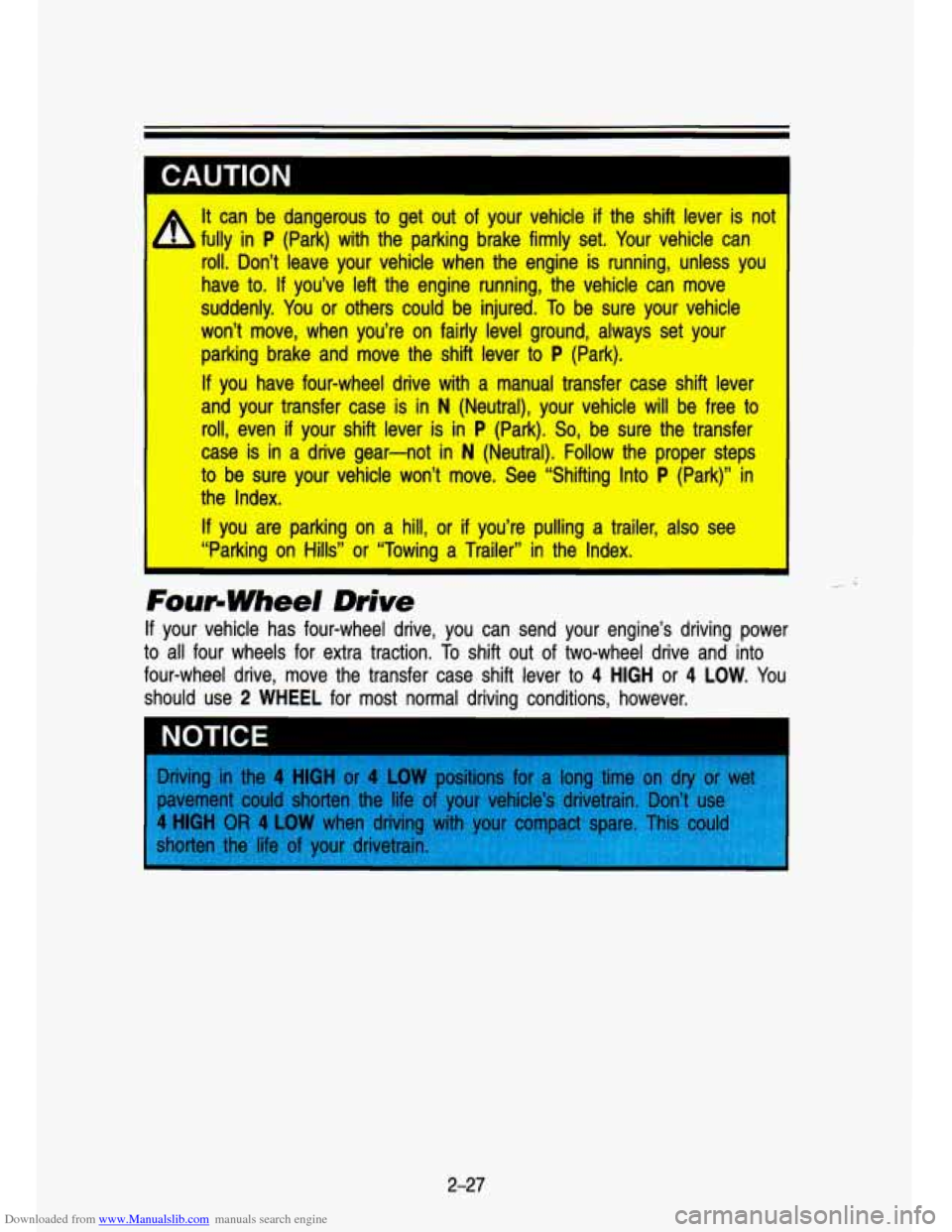
Downloaded from www.Manualslib.com manuals search engine It can be dangerous to get out of your vehicle if the shift llever is not I
fully in P (Park) with the parking brake firmly set. Your vehide can
roll. Don’t leave your vehicle when the engine is running, \
unlless y~
have to.
If you’ve left the engine running, tihe vehicle can move
suddenly.
You or others could be injured. To be sure your vehicle
won’t move, when you’re on fairly level ground, always se\
t your
parking brake and move the shift lever to
P (Park).
If you have four-wheel drive with a manual transfer case shift lever
and your transfer case
is in N (Neutral), your vehide will be free to
roll, even if your shift lever is in P (Park). So, be sure the transfer
case is in a drive gear-not
in ‘N (Neutral)., Follow the proper steps
to be sure your vehicle
won’t move. See “Shifting Into P (Park)” in
the Index.
If you are parking on a hill, or if you’re pulling a trailer, also see
“Farking on Mills” or “Towing a Trailer” in the Index.
If your vehicle has four-wheel drive, you can send your engine’\
s driving power
to all four wheels for extra traction.
To shift out of two-wheel drive and into
four-wheel drive, move the transfer case shift lever
to 4 HIGH or 4 LOW. You
should use
2 WHEEL for most normal driving conditions, however.
2-27
Page 80 of 356
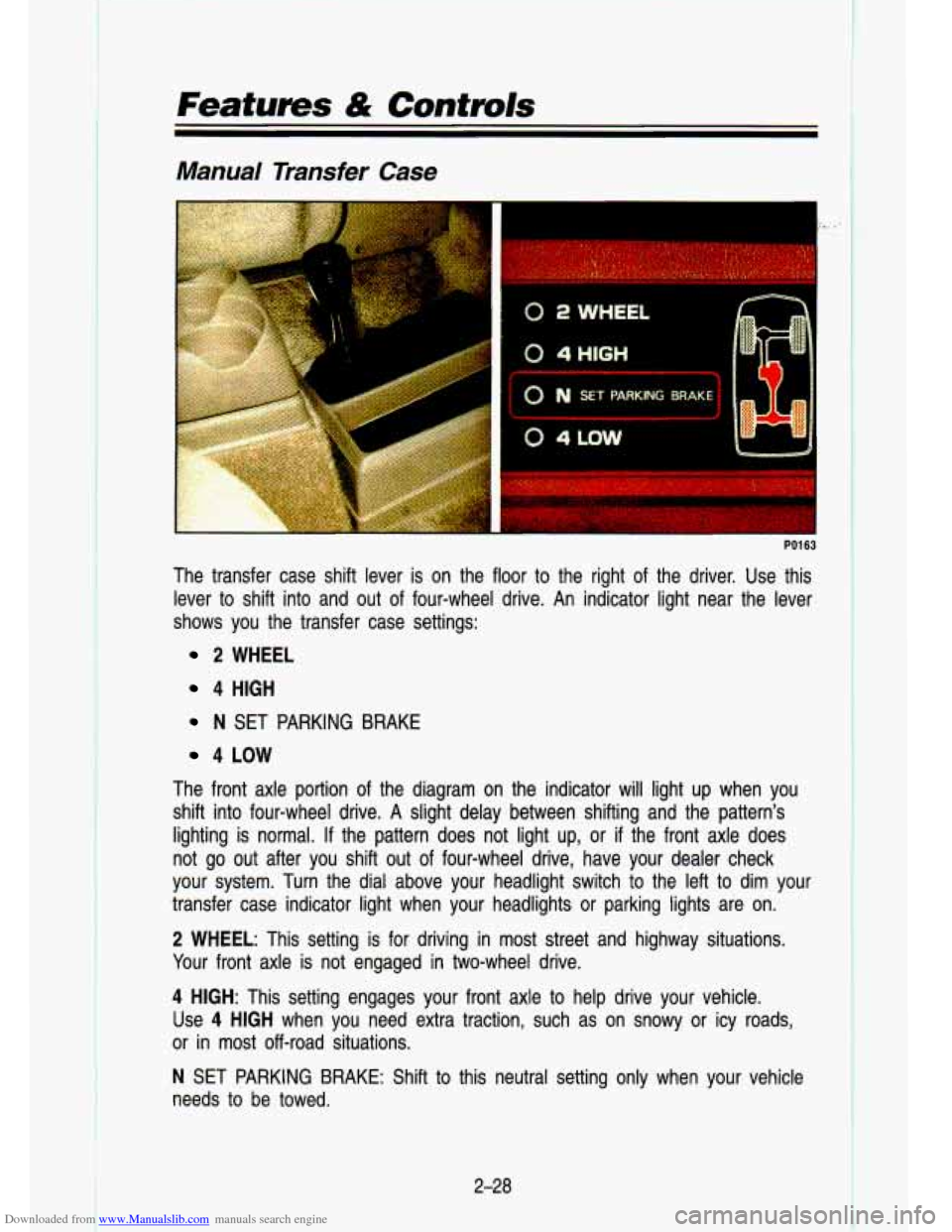
Downloaded from www.Manualslib.com manuals search engine Features & Controls
Manual Transfer Case
I
PO1 63
The transfer case shift lever is on the floor to the right of the driver. Use this
lever
to shift into and out of four-wheel drive. An indicator light near the lever
shows you the transfer case settings:
2 WHEEL
4 HIGH
N SET PARKING BRAKE
4 LOW
The front axle portion
of the diagram on the indicator will light up when you
shift into four-wheel drive. A slight delay between shifting and the patte\
rn's
lighting is normal.
If the pattern does not light up, or if the front axle does
not go out after you shift out
of four-wheel drive, have your dealer check
your system. Turn the dial above your headlight switch
to the left to dim your
transfer case indicator light when your headlights or parking l\
ights are on.
2 WHEEL: This setting is for driving in most street and highway situations.
Your front axle is not engaged in two-wheel drive.
4 HIGH: This setting engages your front axle to help drive your vehicle.
Use
4 HIGH when you need extra traction, such as on snowy or icy roads, \
or in most off-road situations.
N SET PARKING BRAKE: Shift to this neutral setting only when your vehicle
needs
to be towed.
2-28
I
Page 81 of 356
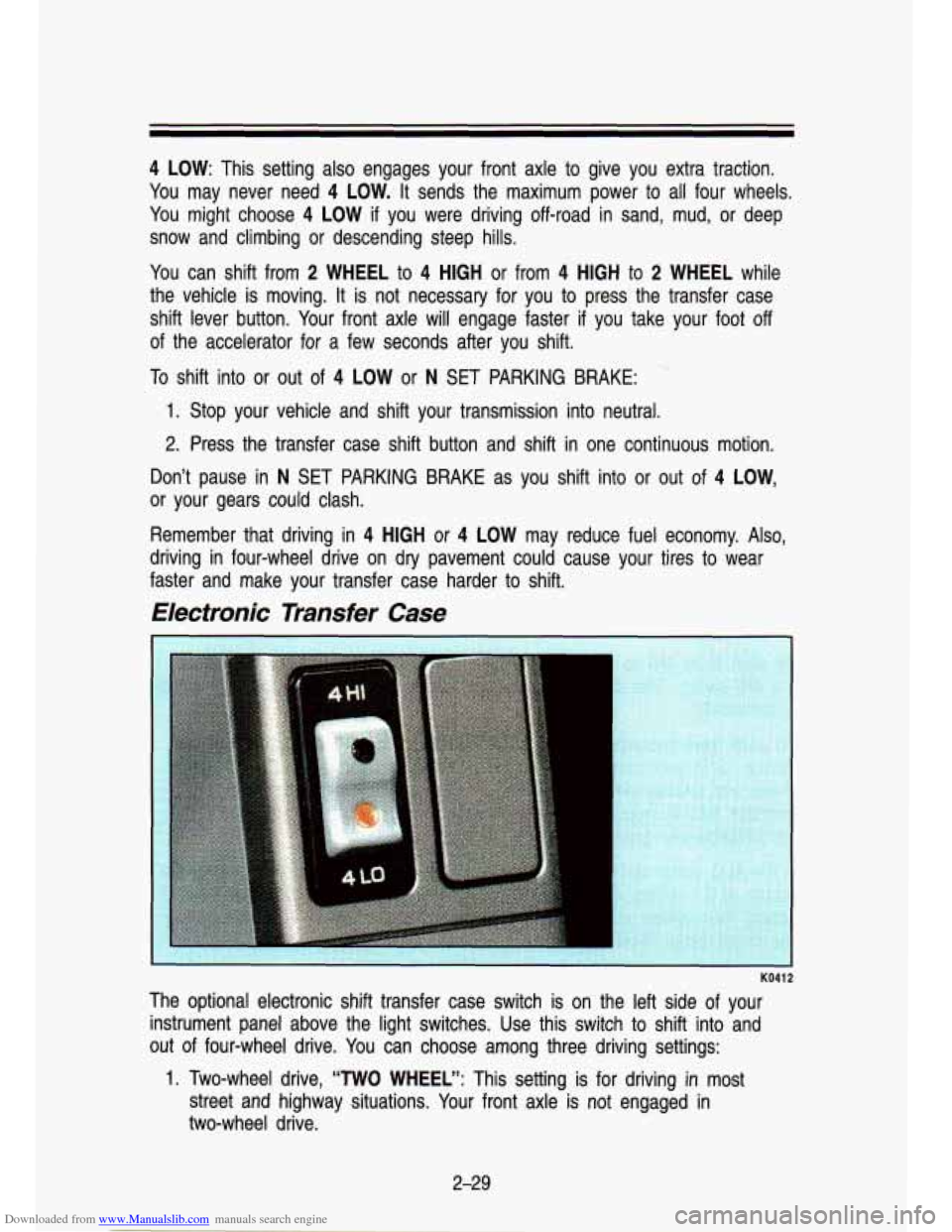
Downloaded from www.Manualslib.com manuals search engine 4 LOW: This setting also engages your front axle to give you extra traction.
You may never need
4 LOW. It sends the maximum power to all four wheels.
You might choose
4 LOW if you were driving off-road in sand, mud, or deep
snow and climbing or descending steep hills.
You can shift from
2 WHEEL to 4 HIGH or from 4 HIGH to 2 WHEEL while
the vehicle is moving.
It is not necessary for you to press the transfer case
shift lever button. Your front axle will engage faster if you take your foot
off
of the accelerator for a few seconds after you shift.
To shift into or out of 4 LOW or N SET PARKING BRAKE:
-
1. Stop your vehicle and shift your transmission into neutral.
2. Press the transfer case shift button and shift in one continuous motion.
Don’t pause in
N SET PARKING BRAKE as you shift into or out of 4 LOW,
or your gears could clash.
Remember that driving in
4 HIGH or 4 LOW may reduce fuel economy. Also,
driving in four-wheel drive on dry pavement could cause your tires to wear
faster and make your transfer case harder to shift.
Electronic Transfer Case
1
KO41 2
The optional electronic shift transfer case switch is on the left side of your
instrument panel above the light switches. Use this switch to \
shift into and
out of four-wheel drive. You can choose among three driving settings:
1. Two-wheel drive, “TWO WHEEL”: This setting is for driving in most
street and highway situations. Your front axle
is not engaged in
two-wheel drive.
2-29
Page 82 of 356
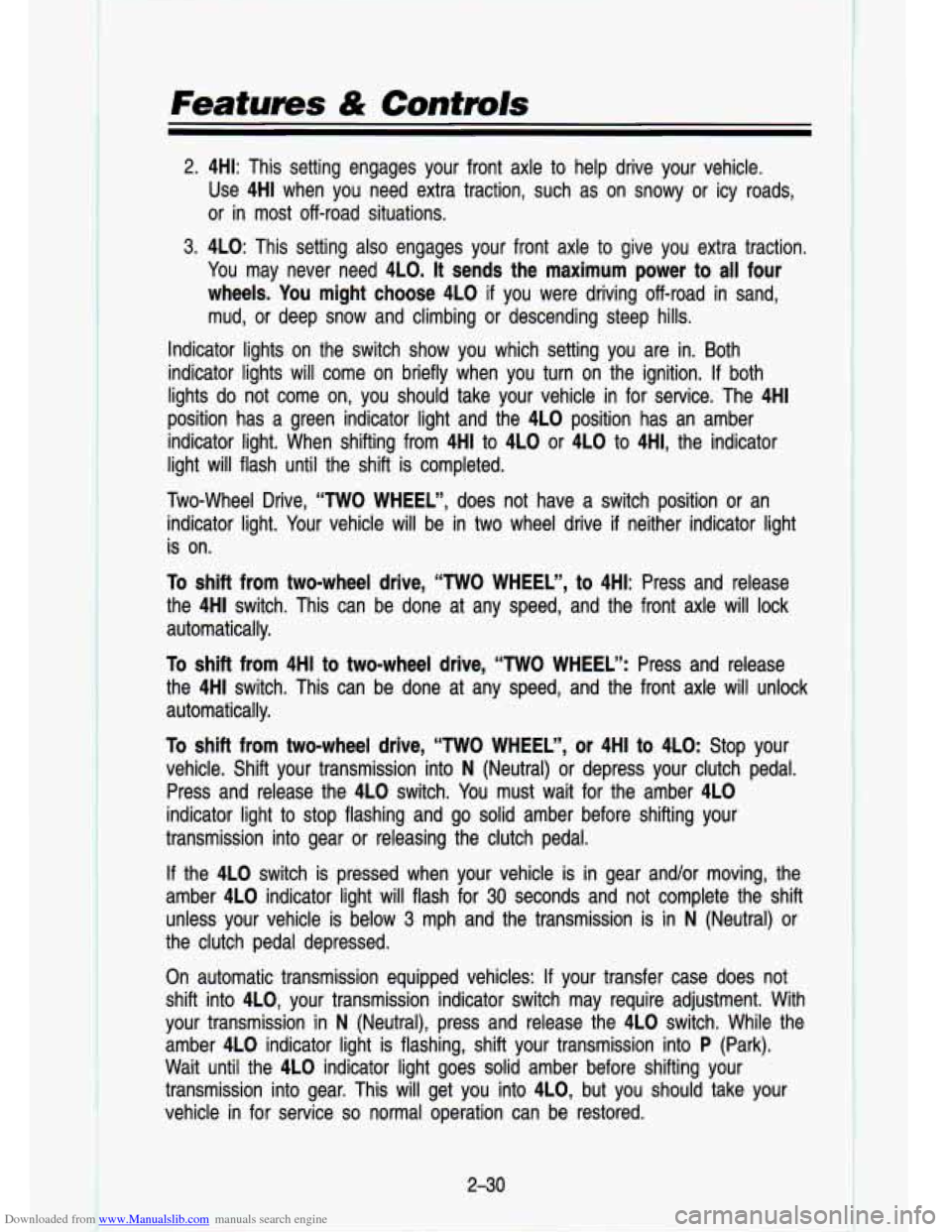
Downloaded from www.Manualslib.com manuals search engine t
Featums & Contmls
2. 4HI: This setting engages your front axle to help drive your \
vehicle. Use 4HI when you need extra traction, such as on snowy or ic\
y roads,
or in most off-road situations.
3. 4LO: This setting also engages your front axle to give you extra traction.
You may never need 4LO. It sends the maximum power to
all four
wheels. You might choose 4L0
if you were driving off-road in sand,
mud, or deep snow and climbing or descending steep hills.
Indicator lights on the switch show you which setting you are \
in. Both
indicator lights
will come on briefly when you turn on the ignition. If both
lights
do not come on, you should take your vehicle in for service. The 4HI
position has a green indicator light and the 4LO position has \
an amber
indicator light. When shifting from 4HI to 4LO or 4LO to 4HI,\
the indicator
light will flash until the shift is completed.
Two-Wheel Drive, “TWO WHEEL”, does not have a switch posi\
tion or an indicator light. Your vehicle will be in
two wheel drive if neither indicator light
is on.
To shift from two-wheel drive,
“TWO WHEEL”, to 4HI: Press and release
the 4HI switch. This can be done at any speed, and the front\
axle will lock
automatically.
To shift from 4HI to two-wheel drive, “TWO WHEEL”: Press and\
release
the 4HI switch. This can be done at any speed, and the front\
axle will unlock
automatically.
To shift from two-wheel drive, ‘‘TWO WHEEL”, or 4HI to 4LO: Stop your
vehicle. Shift your transmission into
N (Neutral) or depress your clutch pedal.
Press and release the 4LO switch. You must wait for the amber 4LO
indicator light to stop flashing and go solid amber before shi\
fting your
transmission into gear or releasing the clutch pedal.
If the 4L0 switch is pressed when your vehicle is in gear and/or moving, the
amber 4L0 indicator light will flash for
30 seconds and not complete the shift
unless your vehicle is below
3 mph and the transmission is in N (Neutral) or
the clutch pedal depressed.
On automatic transmission equipped vehicles:
If your transfer case does not
shift into 4L0, your transmission indicator switch may require adjustment. With
your transmission in
N (Neutral), press and release the 4LO switch. While the
amber 4LO indicator light is flashing, shift your transmission \
into
P (Park).
Wait until the 4LO indicator light goes solid amber before shifting your
transmission into gear. This will get you into 4L0, but you should take your
vehicle in for service
so normal operation can be restored.
2-30
Page 155 of 356
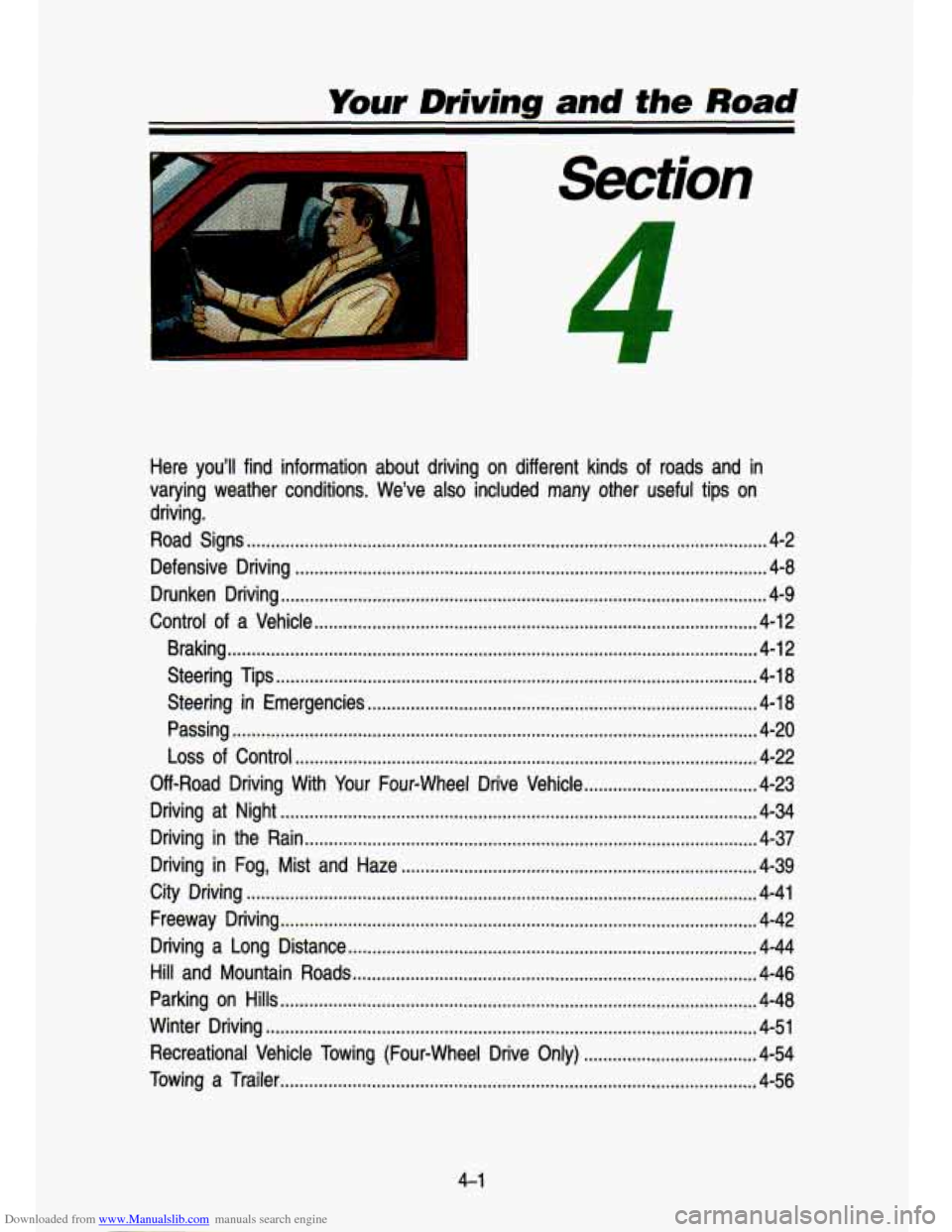
Downloaded from www.Manualslib.com manuals search engine Your Driving and the Road
.
Section
Here you’ll find information about driving on different kinds\
of roads and in
varying weather conditions
. We’ve also included many other useful tips on
driving
.
Road Signs ........................................................................\
.................................... 4-2
Defensive Driving
........................................................................\
.......................... 4-8
Drunken Driving
........................................................................\
............................. 4-9
Control
of a Vehicle ........................................................................\
.................... 4-12
Braking
........................................................................\
...................................... 4-12
Steering Tips
........................................................................\
............................ 4-18
Steering in Emergencies
........................................................................\
......... 4-18
Passing
........................................................................\
..................................... 4-20
Loss of Control ........................................................................\
........................ 4-22
Off-Road Driving With Your Four-wheel Drive Vehicle
.................................... 4-23
Driving at Night
........................................................................\
........................... 4-34
Driving in the Rain
........................................................................\
...................... 4-37
Driving in Fog, Mist and Haze
........................................................................\
.. 4-39
City Driving
........................................................................\
.................................. 4-41
Freeway Driving
........................................................................\
........................... 4-42
Driving a Long Distance
........................................................................\
............. 4-44
Hill and Mountain Roads
........................................................................\
............ 4-46
Winter Driving
........................................................................\
.............................. 4-51
Recreational Vehicle Towing (Four-wheel Drive Only)
.................................... 4-54
Towing a Trailer
........................................................................\
........................... 4-56
Parking
on Hills ........................................................................\
........................... 4-48
4-1